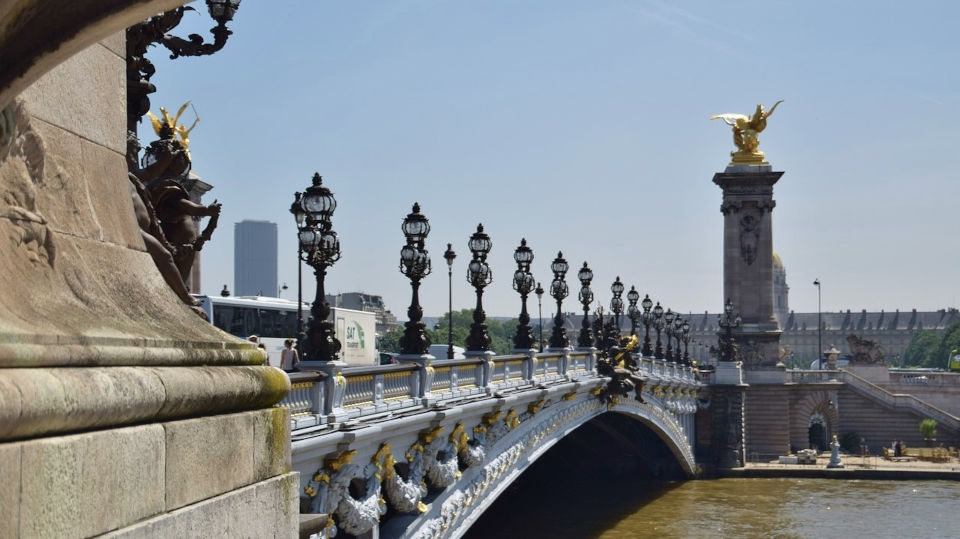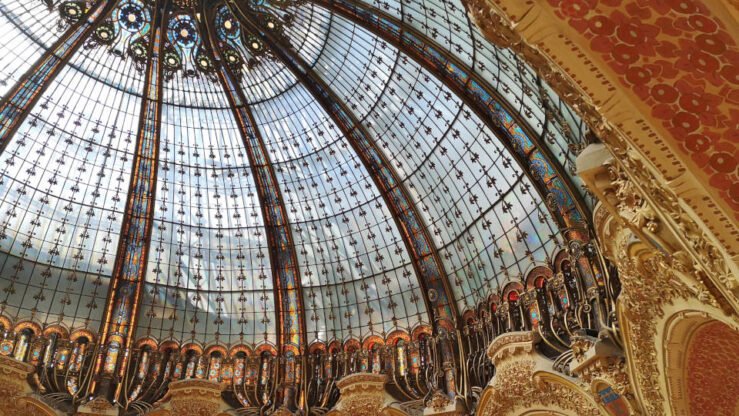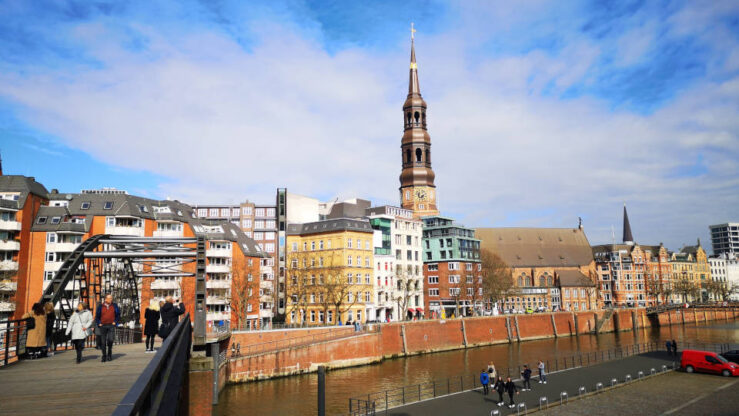Seine River Cruise – Explore 25 Iconic Paris Bridges
1. Quai d’Orsay
2. Quai des Tuileries and the Louvre
3. Île de la Cité
4. Île Saint-Louis
5. Eiffel Tower and Île aux Cygnes
6. Quai d’Austerlitz and Quai de Bercy
Several cruise companies offer the experience of taking a trip on the Seine River under the famous bridges of Paris. On a one- or two-hour river tour following the flow of the Seine, you can explore the iconic Paris bridges from below. There are plenty of cruise options – whether you want to go during the day or at night – and whether you want a lunch or a dinner experience on board the boat.
Some of the bridges in Paris are more famous than others. The Pont Neuf, Pont Alexandre III, and Pont des Arts are all bridges that most visitors have heard of, whereas other bridges belong to the more unknown category. In addition to the spectacular bridges, you will on a river cruise also be able to explore iconic Paris sights such as the Eiffel Tower, the Louvre, the Musée d’Orsay, the Bouquinistes, as well as the Notre-Dame Cathedral from a different angle!
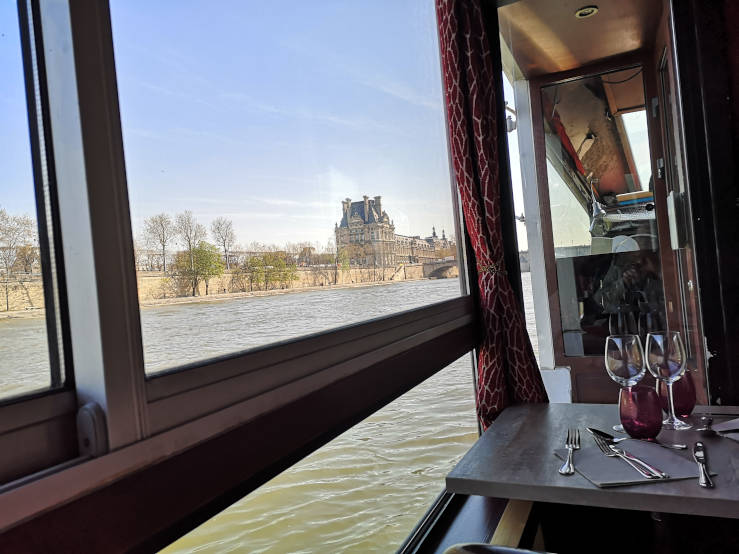
Photo: Travel In Culture
Some bridges can also surprise for various reasons… for example, the Pont Neuf and the Pont de Sully both count as two bridges! Be aware that there are many more than 25 bridges over the Seine – this is only a sample of well-known and lesser-known bridges!
The ornate bridge Pont Alexandre III is unparalleled, reminiscent of the fabulous Belle Époque period around 1900 in Europe, particularly Paris. The era was characterised by economic prosperity, technological and scientific innovations, art, literature, music, and new fashion trends. Light entertainment was introduced to the Parisian bourgeoisie.
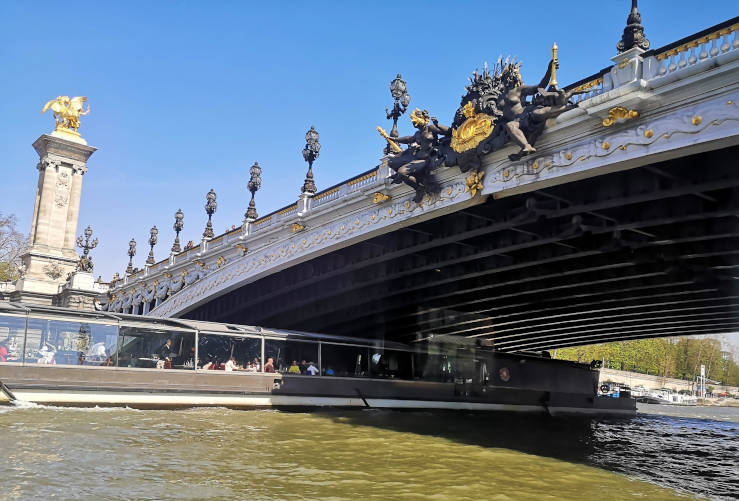
Photo: Travel In Culture
Places such as Montmartre’s cabarets, Maxim’s Paris, Casino de Paris, Folies Bergère and Moulin Rouge opened, haute-couture saw the light of day with feathers and furs, Art Nouveau was the new architectural style, and Toulouse-Lautrec’s poster art became known. The ‘joie de vivre’ replaced the hard times during the Napoleonic Wars.
The Eiffel Tower was erected for the World’s Fair in 1889, and the Pont Alexandre III was completed for the Exposition Universelle de 1900. The bridge connects the ensemble of the Grand Palais / Petit Palais, also built for the Universal Exhibition, to the Hôtel des Invalides on the opposite side of the river Seine, also known as the Republican Axis.
The magnificent bridge spanning the Seine had its first stone laid by Tsar Nicholas II of Russia in 1896 and thus symbolises the relationship between France and Russia at the time. In terms of ornamentation, it surpasses all other bridges in Paris.
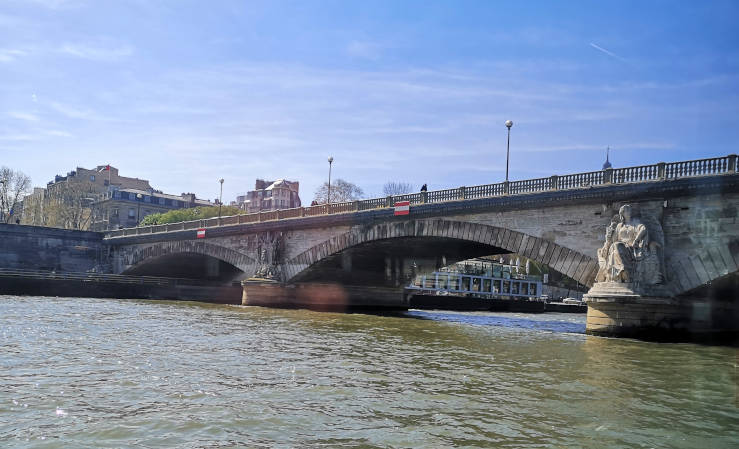
Photo: Travel In Culture
The original suspension bridge was begun in 1821 and designed by the engineer Claude Navier. This first attempt was constructed where the current Pont Alexandre III is, aligned with the Hôtel des Invalides.
However, Navier’s construction was with its single span not safe enough. In 1854, it was thus replaced by a new bridge for the Exposition Universelle de 1855. The two sculptures, Land Victory by Victor Vilain and Maritime Victory by Georges Diébolt, were added upriver and downstream, respectively.
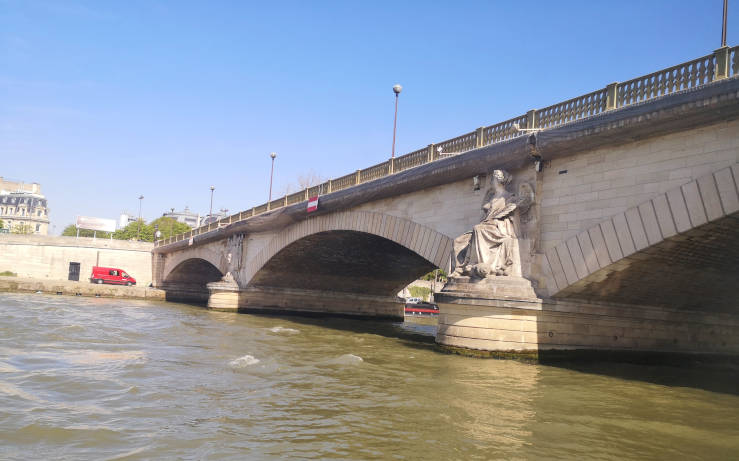
Photo: Travel In Culture
The arch bridge was designed by Paul-Martin Gallocher de Lagalisserie and inaugurated by Napoleon III in 1856. It was named after the Battle of Alma in the Crimean War, where the Franco-British alliance defeated the Russians in 1854.
The bridge features two military statues made by Georges Diébolt and Arnaud, respectively.
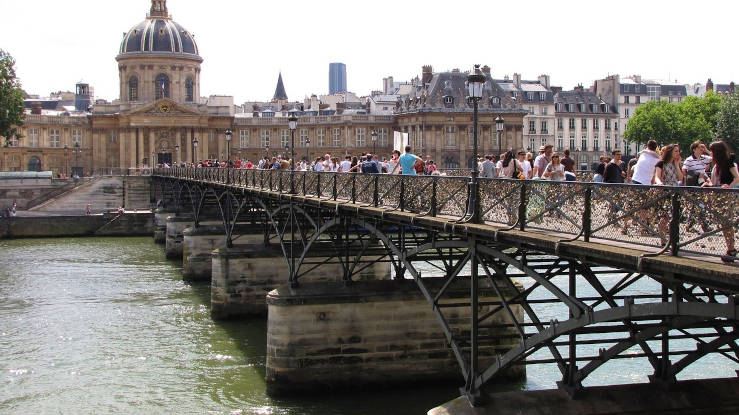
Photo: Merzhin / Pixabay
This pedestrian bridge leads to the Palais du Louvre, formerly known as the Palais des Arts – hence the name.
The original bridge was built at the beginning of the 19th century under Napoleon Bonaparte and was the first metal bridge in the city. Pedestrians were charged a small amount to use the bridge!
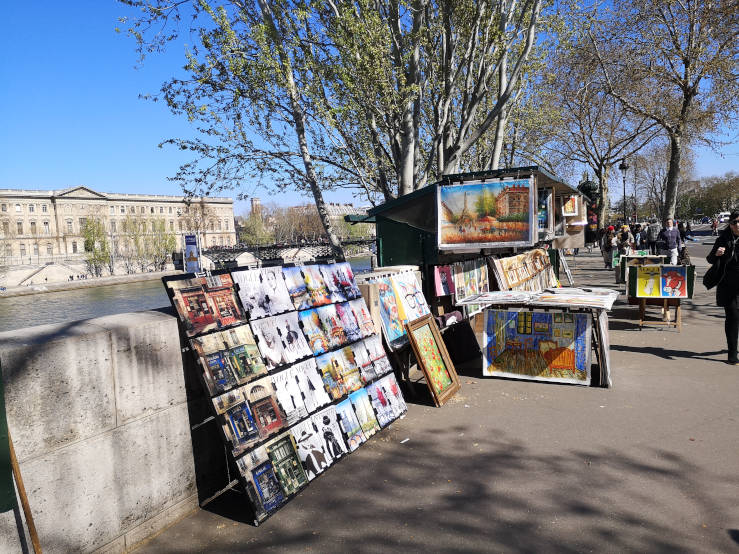
The bouquinistes in front of the Pont des Arts | Photo: Travel In Culture
The World Wars damaged the Pont des Arts – and so did multiple collisions with boats over the years. Therefore, it was closed in the late 1970s. A nearly identical replica was completed in 1984. Today, the famous bridge is sometimes used for art exhibitions and is much frequented by artists, including painters and photographers. Until 2015, it was allowed to attach love locks to the romantic bridge, but that is now forbidden due to the heavy weight of the locks. Instead, it is a favoured spot for a picnic!
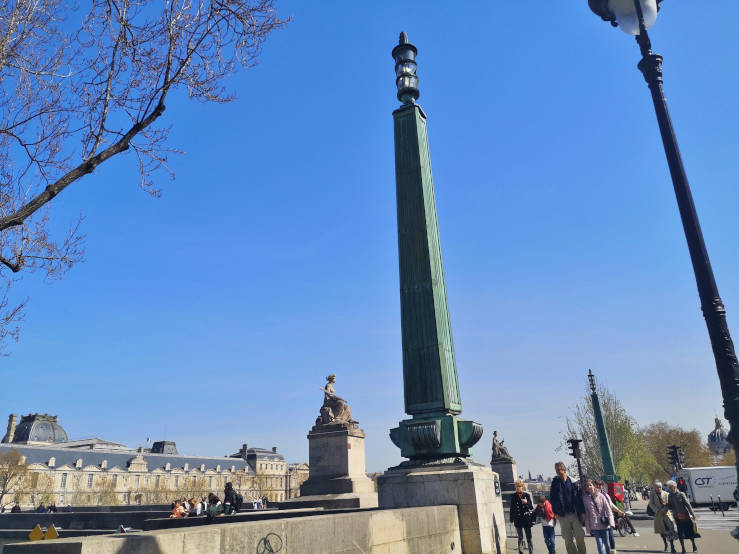
Photo: Travel In Culture
Another eye-catching bridge in Paris is the Pont du Carrousel, between the Quai des Tuileries at the Louvre and the Quai Voltaire. The architect of the original bridge was Antoine-Rémy Polonceau, who constructed an arc bridge with the relatively new material cast iron. Stone sculptures by Louis Petitot representing Industry, Abundance, The City of Paris, and The Seine were added at each corner. In 1834, it got its current name when King Louis-Philippe named it after the Arc de Triomphe du Carrousel right in front of the Tuileries.
However, the bridge was completely rebuilt in 1930 by the architects Malet and Lang since it was judged to be too narrow for modern traffic and too low for river traffic. Consequently, it was ‘moved’ a few metres downstream, now completely aligned with the Arc de Triomphe du Carrousel.
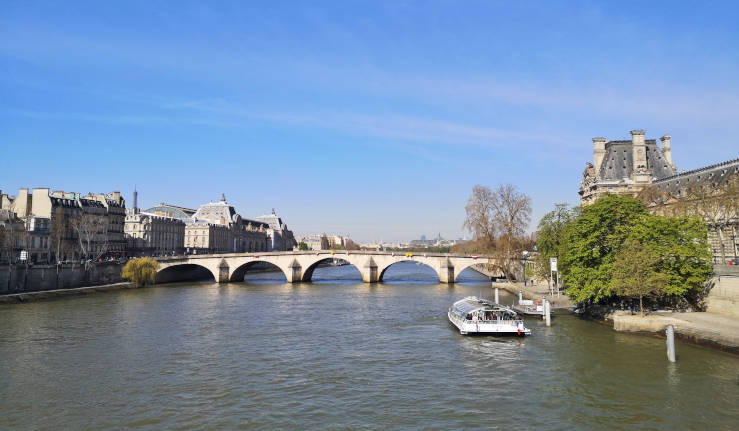
Photo: Travel In Culture
Pont Royal is the third oldest of the bridges of Paris and has five elliptical arches. It was originally a wooden toll bridge, replacing a small ferry that had served for crossing the Seine since the mid-1500s. At that time, it was known as Pont Sainte-Anne or Pont Rouge (the red bridge).
In 1660, it was completely rebuilt after both fires and floods. However, this new bridge did not last long. A stone bridge was finally constructed in 1689. King Louis XIV gave it the name Pont Royal.
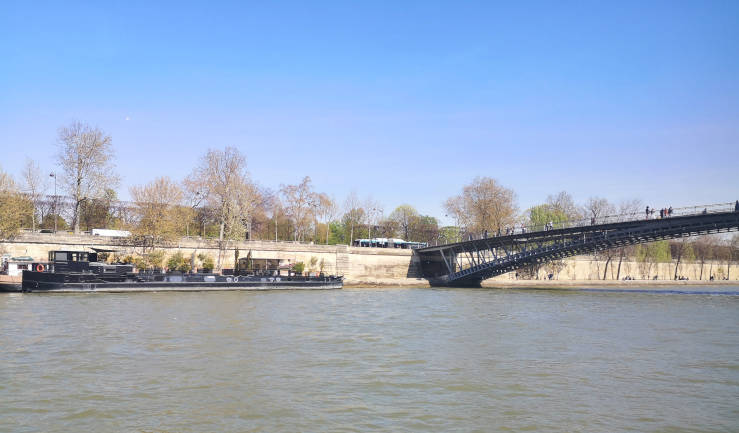
Photo: Travel In Culture
The footbridge between Musée d’Orsay and the Tuileries Gardens is named after the first president of Senegal, Léopold Sédar Senghor. The current metallic bridge with a single span is from 1999, replacing bridges from 1961 and 1861. The first bridge was a cast iron bridge inaugurated by Napoleon III and designed by the engineers behind the Pont des Invalides. It was formerly named Passerelle Solférino after the Battle of Solferino.
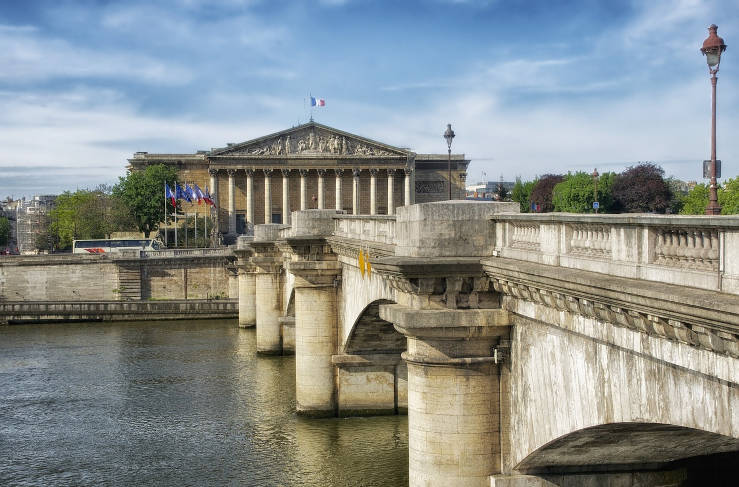
Photo: David Mark / Pixabay
This arch bridge from 1791 connects the Quai d’Orsay on the Seine’s Rive Gauche to the Place de la Concorde on the Rive Droite. It was formerly known as both the Pont Louis XVI and the Pont de la Révolution.
Over the years, there have been multiple statues along the sides. First, Napoleon placed statues of French generals, and later, these were replaced with French ministers, royal generals, and sailors. However, the statues caused too much weight on the bridges and were moved to Versailles by Louis-Philippe I!
Today, the Pont de la Concorde accounts for some of the heavy traffic across the river.
The Pont Neuf is one of the famous bridges in Paris that you will notice on a river cruise on the Seine.
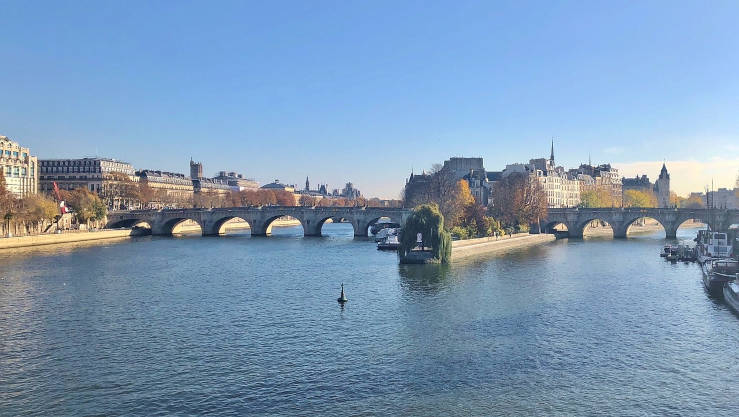
Photo: Bill Kasman / Pixabay
Despite its name, Pont Neuf is the oldest bridge in Paris, completed and inaugurated by Henry IV in 1607! The bridge counts for two bridges! It was built as a ‘double’ bridge consisting of a 7-arched section and a 5-arched section on each side of the île de la Cité. In the first centuries, there were shops along the bridges. However, this came to an end under the reign of Napoleon III when the bridge foundations were entirely rebuilt.
The two bridge sections spanning over the Seine had another restoration in 1994 – 2007, marking the year of its 400th anniversary.
For the decoration of the Pont Neuf, there are 381 stone masks representing divinities from ancient mythology. Notice the equestrian statue of King Henry IV in front of the bridge.
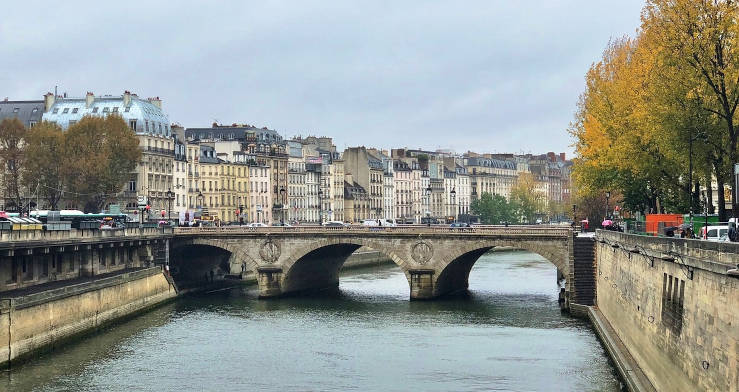
Photo: Bill Kasman / Pixabay
The Pont Saint-Michel links the Place Saint-Michel on the left riverbank to the Île de la Cité. The bridge dates to 1857, but already in 1387, a stone bridge stood here. However, the harsh winter in 1407-1408 left its mark, and the relatively new bridge collapsed.
Later attempts during the following centuries did not produce a solid and durable bridge either, not until the current bridge by Paul-Martin Gallocher de Lagalisserie and Paul Vaudrey was built.
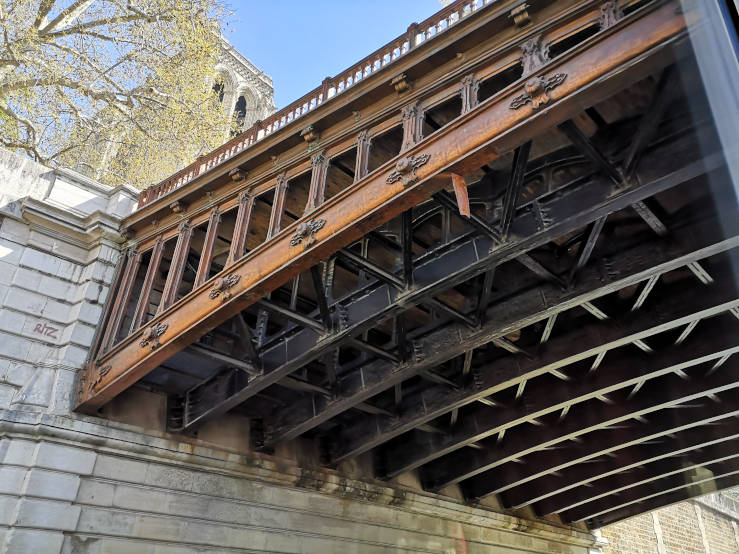
Photo: Travel In Culture
The Pont au Double was constructed to meet the need for patients to be transported to the Hôtel Dieu hospital located on the Île de la Cité. People were, though, required to pay a toll (a ‘double fee’) to use the bridge to fund the construction of it – hence the name.
The bridge was ready for use in 1634, but unfortunately, it already collapsed in 1709. The current Pont au Double was constructed in 1883 as a cast-iron bridge.
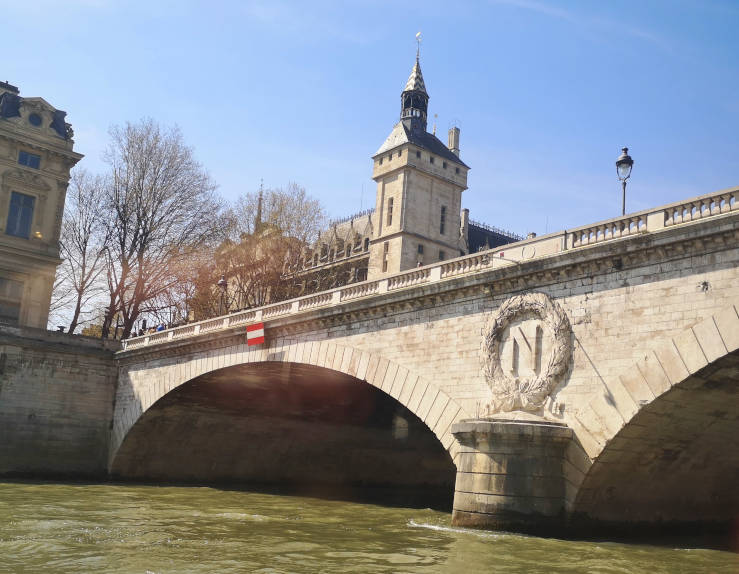
Photo: Travel In Culture
Like many other bridges in Paris, the Pont au Change also had several predecessors. In the past, in the 12th century, the bridge had money changers and goldsmith shops established on the very bridge – hence the name. The current bridge was built under Napoleon III in 1860.
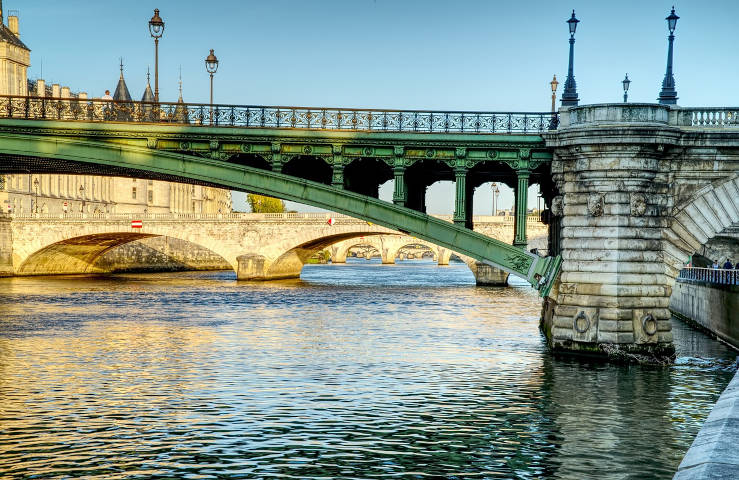
Photo: Jean-Philippe Fourier / Pixabay
The Pont Notre-Dame is another famous bridge that you will pass on a Seine River cruise – it has existed in Paris since antiquity, but like many other Parisian bridges, it has been reconstructed multiple times. One of the collapses, in 1499, was due to the overloading of houses built on the bridge itself. About sixty houses were at the time burdening the bridge with their weight.
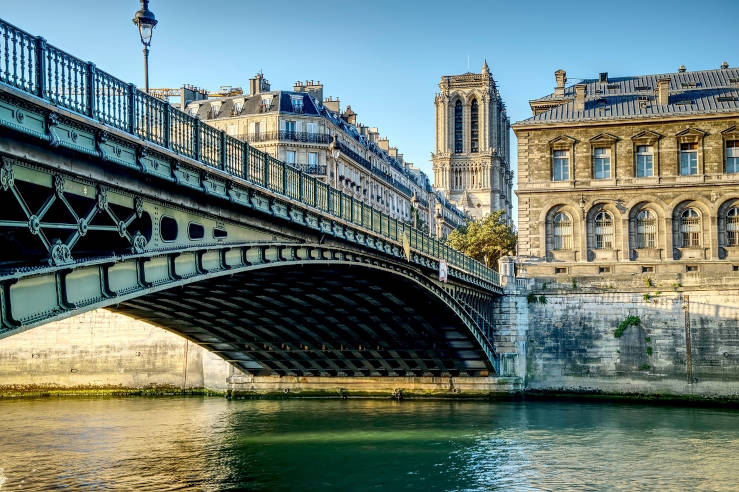
Photo: Jean-Philippe Fourier / Pixabay
Pont d’Arcole is a beautiful bridge over the Seine that connects the city to the Île de la Cité, constructed in 1856 and is the first bridge in Paris without an auxiliary support in the river. It replaced an earlier two-span pedestrian suspension bridge.
The new bridge was a traffic bridge that had to take into account the urban development in the area. It was named to commemorate Napoleon Bonaparte I’s victory at the Battle of Arcole.
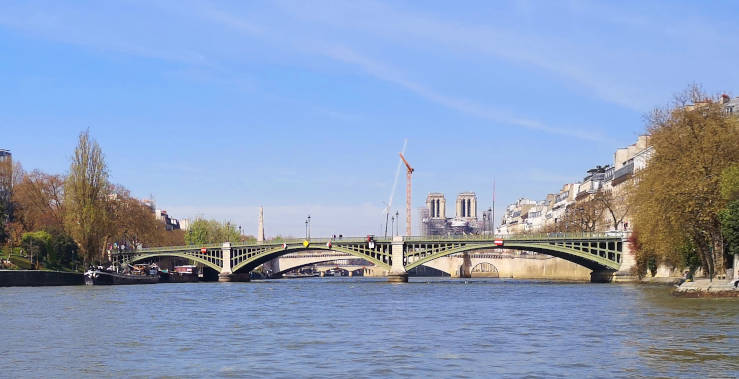
Photo: Travel In Culture
The other ‘double bridge’ in Paris included here, which you probably for this reason will pass twice on your Seine River cruise, is the Pont de Sully. It is two separate bridges, constructed in 1876 as part of the great Haussmann urban project and named after the Duke of Sully, Maximilien de Béthune (1560-1641).
Both bridge sections consist of cast iron arches and provide panoramic views over the riverbanks.
The current bridges replace two earlier pedestrian suspension bridges (Passerelle Damiette and Passerelle de Constantine).
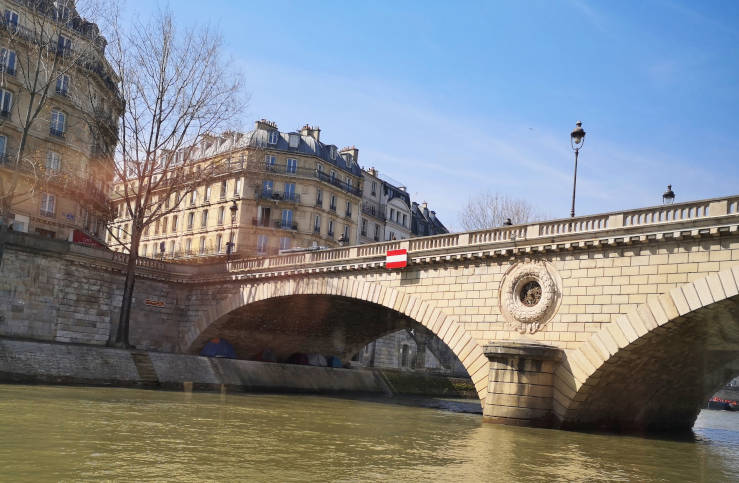
Photo: Travel In Culture
King Louis-Philippe initiated the construction of the bridge in 1833 after a design by the architects Séguin Brothers.
The bridge burned down during the Revolution of 1848 but was fully restored in 1862. An earlier name of the bridge is Pont de la Réforme.
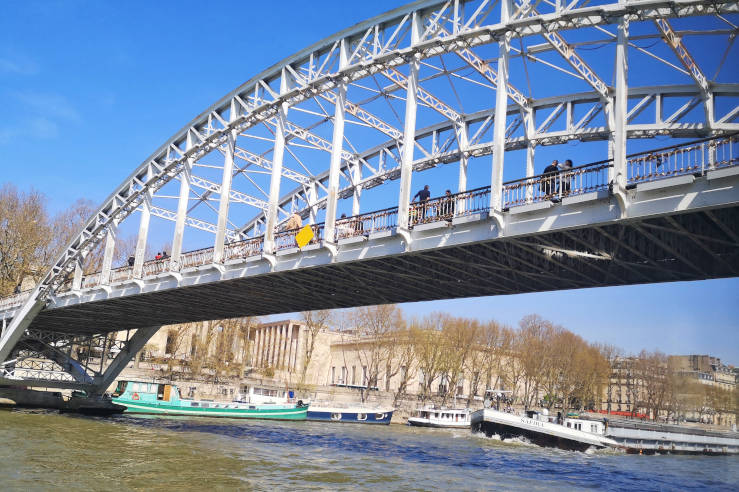
Photo: Travel In Culture
This metallic footbridge connects the Avenue de New York to the Quai Branly. The bridge was originally constructed to facilitate pedestrian access to the 1900 World’s Fair across the Seine and is one of the cool examples of engineering in Paris towards the end of the 1800s, just like the Eiffel Tower!
It is shrouded in mystery because a German diplomat in 1989, right after the Fall of the Berlin Wall, was murdered on the very Passerelle Debilly. The bridge was used as a meeting point by the secret service of East Germany!
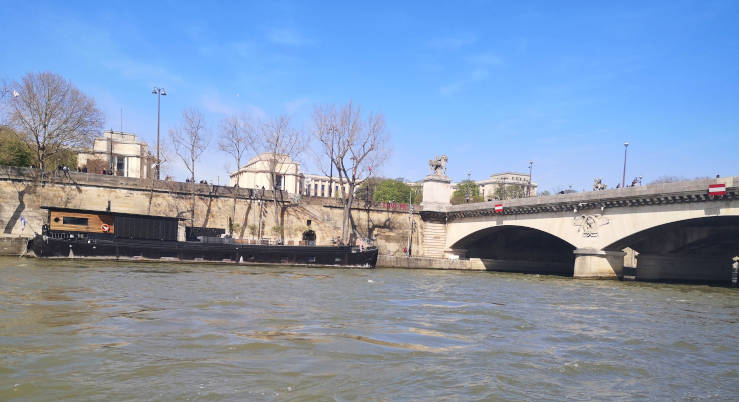
Photo: Travel In Culture
Pont d´Iéna is a beautiful bridge in Paris, spanning over the river Seine, that you will pass on a boat cruise at the Eiffel Tower. The bridge comprises five wide arches, four piers and decorations of imperial eagles. Moreover, four sculptures of warriors of distinct ethnicities (Greek, Arab, Roman and Gallic) sit atop the pylons at the ends.
Napoleon I was behind the construction of the bridge, and he named it after the victory in the Battle of Jena in 1806.
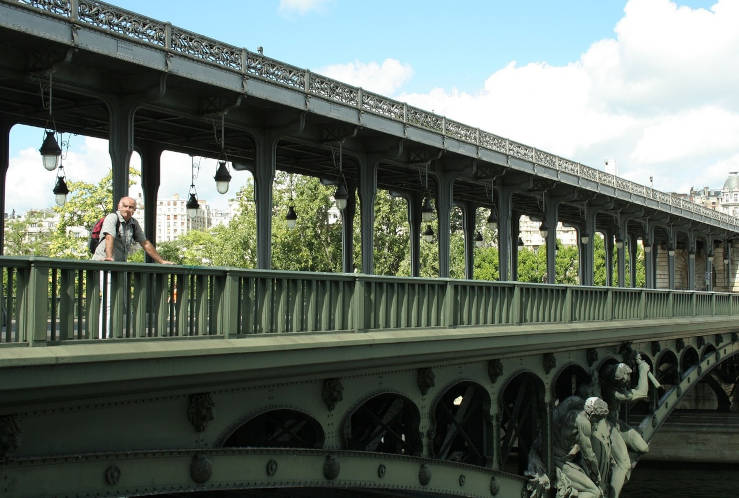
Photo: Katerina Rubasova / Pixabay
The steel bridge Pont de Bir-Hakeim passes through the Île aux Cygnes and was constructed between 1903 and 1905. Four stone statues decorate it, representing science, labour, electricity, and commerce, respectively. The bridge, named to commemorate the Battle of Bir Hakeim, replaced an older bridge dating from 1878.
The architect was Jean-Camille Formigé, who was also the architect of the Viaduc d’Austerlitz, a few kilometres east of the Pont de Bir-Hakeim. The striking thing about this bridge is that it has been designed on two levels, one for cars and pedestrians and another for the Paris metro.

Photo: Travel In Culture
Another steel bridge passing through the Île aux Cygnes is the Pont de Grenelle from 1966. The first bridge on site was constructed already in 1873.
The bridge crosses the long island just behind the famous replica of the Statue of Liberty.
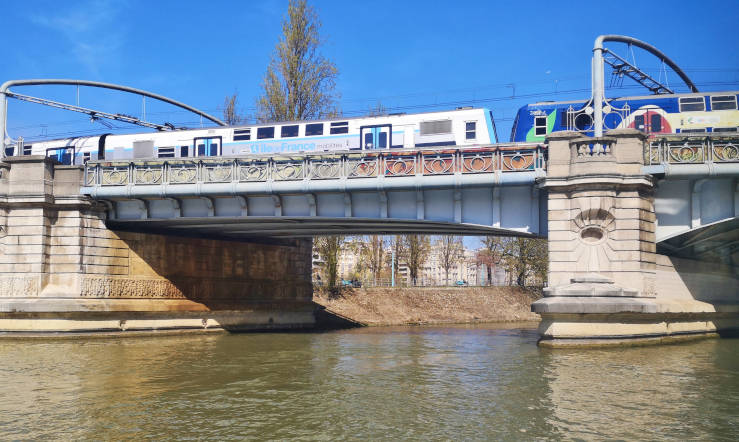
Photo: Travel In Culture
Between the Pont de Bir-Hakeim and the Pont de Grenelle, a railway bridge crosses the Seine, the Pont Rouelle. That is the third steel bridge over the Île aux Cygnes!
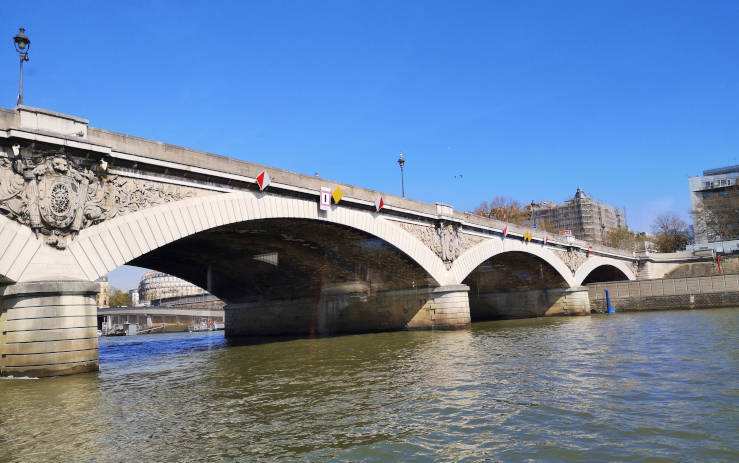
Photo: Travel In Culture
The original 5-arched bridge was constructed in 1801 by Becquey de Beaupré. The Battle of Austerlitz in 1805 has had the bridge named after it. The bridge links the 12th arrondissement to the 5th / 13th arrondissements right at the entrance to the Jardin des Plantes.
Reconstruction work was carried out in 1854, extending the width.
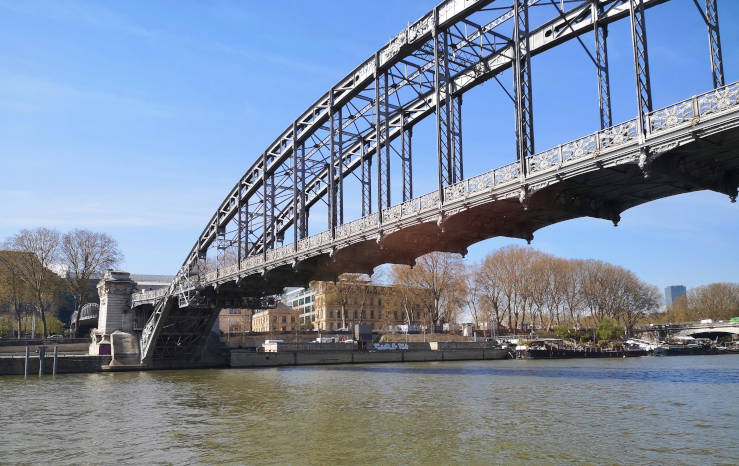
The Viaduc d’Austerlitz | Photo: Travel In Culture
Next to the Pont d’Austerlitz, the beautiful single-spanned Viaduc d’Austerlitz was built in 1904 to allow rail traffic to cross the Seine at this point.
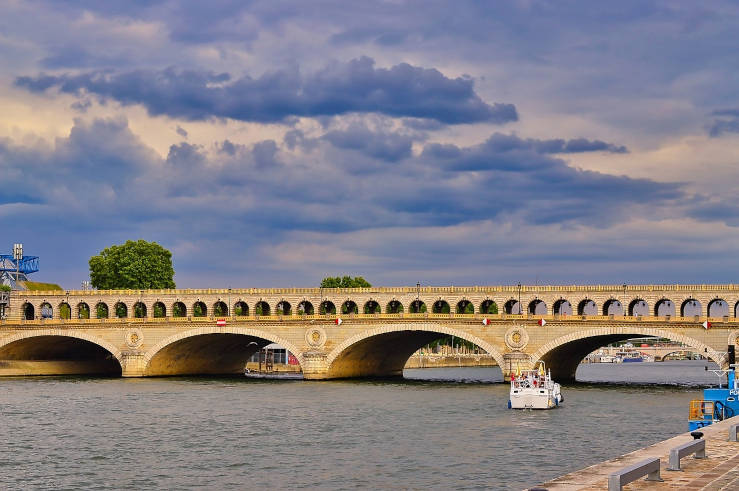
Photo: Jean Louis Servais / Pixabay
When cruising the Seine River, you will, between the 12th and 13th arrondissements, pass the Pont de Bercy, an imposing bridge construction on two levels permitting both car traffic and the Paris metro.
In 1832, a suspension bridge replaced the ferry traffic at this point, and again in 1864, the structure was reinforced. Later, in 1904, the Pont de Bercy also opened to rail traffic and now serves Line 6 of the Paris Metro.
Read next: Montmartre, Place du Tertre, Sacré-Coeur Paris – History & Cultural Heritage and A Stroll Along Charming Canal Saint Martin in Paris
Seine River Cruise – Explore 25 Iconic Paris Bridges
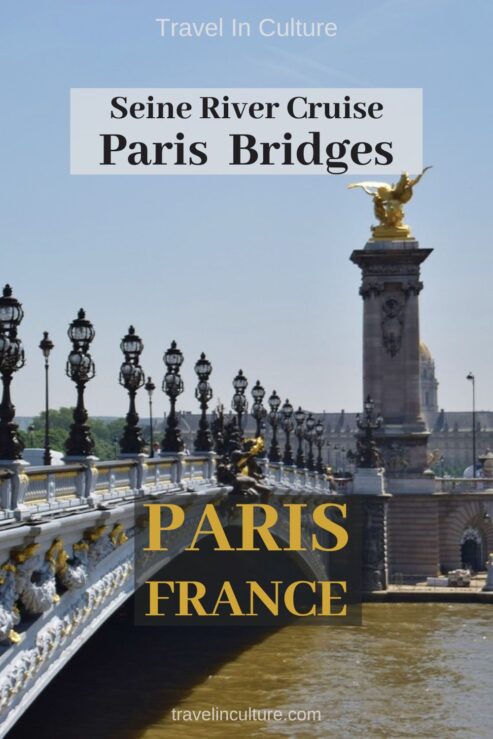
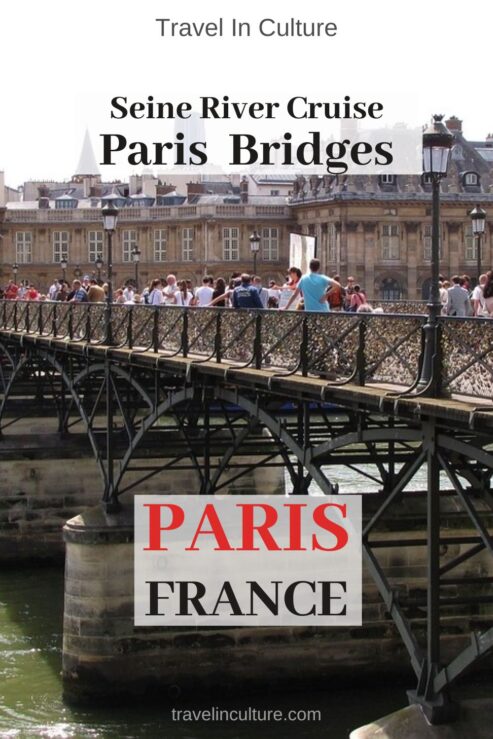
Featured image of
Seine River Cruise – Explore 25 Iconic Paris Bridges:
Ernesto Velazquez / Pixabay
Paris Bridges – Seine River Cruise


